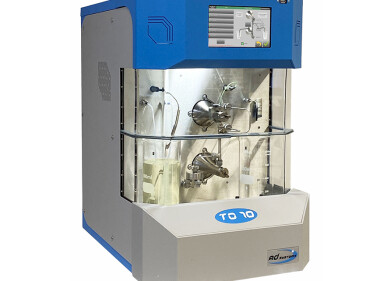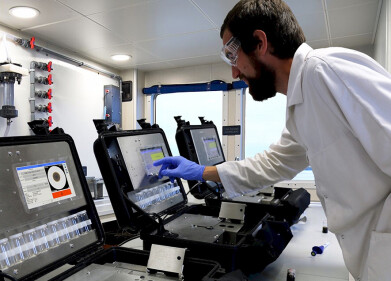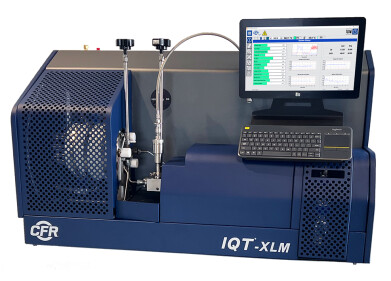Fuel analysis
The Most Modern Density Measurement in Fuel Analysis
Apr 24 2009
Shortly after the market launch of Anton Paar’s DMA Generation M density meters, Analytik-Service Gesellschaft (ASG), the leading service provider in the field of fuel analysis, purchased a DMA 4500 M with a sample changer Xsample 452. How does the DMA 4500 M perform in comparison to the previous models DMA 48 and DMA 4500 and what were the decisive factors for the decision to purchase the new instrument?
ASG was the first ever pan-European accredited testing institute for the analysis of fuels made from biogenic raw materials. It was established in 1992 on behalf of the fuel trade, government committees, the automobile industry and other associations. The headquarters of ASG is in Neusäß, near Augsburg, Germany. Further offices in Australia and Brazil successfully put German know-how into practice abroad.
Besides the routine analysis of biogenic and fossil fuels, ASG engineers are particularly proud of the method they developed to detect steryl-glycosides using thin-layer chromatography. ASG also has an established reputation for the production of reference oils.
Since the end of 2007 ASG has been advising manufacturers of biofuels on how to optimise their production process. These consultations take place in ASG’s own technical centre with its wide range of equipment and measuring instruments, which are used to optimise chemical reactions in oil or test new recipes. Other issues are the selection of feedstocks and finding energy-conserving reaction conditions to produce fuels which conform to specific norms. How much catalyst is required? Which reaction conditions are needed to ensure complete transesterification? The answers to these questions and more can be found using ASG’s well-equipped laboratory and implementing their knowledge collected throughout 15 years in the field.
Determining the Density at ASG
The first step in every analysis at ASG is the determination of density. Density determination is simple, quick and inexpensive, and provides a sum parameter which is ideal for plausibility checks on samples. Is the sample diesel, petrol or rapeseed oil? Is the product description consistent with the provided sample? The samples which are analysed are
oils and biogenic fuels with a viscosity of 3 to 50 mPa.s which come from oil mills, biodiesel manufacturers and trading companies.
Shortly after the laboratory opens for the day, the new sample changer is filled with samples. Each sample is quickly identified with a bar code reader. There is space for up to 48 samples and each sample can be assigned its own method and measuring temperature. And that is all that needs to be done: measurement, cleaning, verification and data processing are all performed by the DMA 4500 M. Any measurement errors are detected automatically.
The New DMA M
When developing DMA Generation M the focus was on making the measurements and results as reliable as possible. A cautious further development of the existing DMA series was not enough – Anton Paar’s aims were much more ambitious. In particular, three new technical highlights now lead the way to reliable results: FillingCheck™, U-View™ and ThermoBalance™.
FillingCheck™
Anton Paar and the inventor of the digital density meter, Dr. Stabinger, developed FillingCheck™ to prevent the results being influenced by any gas bubbles filled with the sample. FillingCheck™ uses a measurement to detect filling errors and gas bubbles, and alerts the operator with a warning in the results list. Combined with a sample changer, the new
Generation M density meter is a very economical system for ASG. DMA 4500 M instruments can be left to work unattended during the day and when the workload is large, samples can be measured at night.
U-ViewT™
Besides providing error detection based on a measurement, Anton Paar also wanted to offer an optical check of the whole measuring cell. To meet this requirement, Anton Paar engineers, in cooperation with Dr. Stabinger, developed U-View™. U-View™ shows live images of the U-tube on the display with the whole filled-in sample clearly visible. If required, an image of the filled U-tube can be stored as a data file attached to the measurement protocol along with the results. For ASG this means the results can be verified at a later date should there be a query.
ThermoBalance™
The prerequisite for exact density measurement is precise temperature control and adjustment. ThermoBalance™ makes extremely short thermostatting times possible – and allows measurements at different temperatures with only one density adjustment. In practice this means rapid throughput and just one density adjustment required, even when the measuring temperatures vary greatly, as is often the case at ASG. This comes from having to follow a number of different norms, and also in order to fill highly viscous samples into the measuring cell.
Summary: Anton Paar’s new DMA 4500 M
According to the head of the laboratory, Dr. Tröster, the new DMA 4500 M sets new standards in automation and reliability of the results: “If we view the capabilities of the new generation of Anton Paar density meters and our current developments in the laboratory, we are more than sure that we made the right choice.“
Digital Edition
PIN 25.6 Buyers' Guide
January 2025
Buyers' Guide Directory - Product Listings by Category - Suppliers Listings (A-Z) Articles Analytical Instrumentation - ASTM D7042: The Quantum Leap in Viscosity Testing Technology -...
View all digital editions
Events
SPE Hydraulic Fracturing Technology Conference and Exhibition
Feb 04 2025 The Woodlands, TX, USA
Feb 05 2025 Guangzhou, China
Trinidad and Tobago Energy Conference 2025
Feb 10 2025 Point Lisas, Trinidad
Feb 11 2025 Lagos, Nigeria
Feb 13 2025 Manama, Bahrain



















